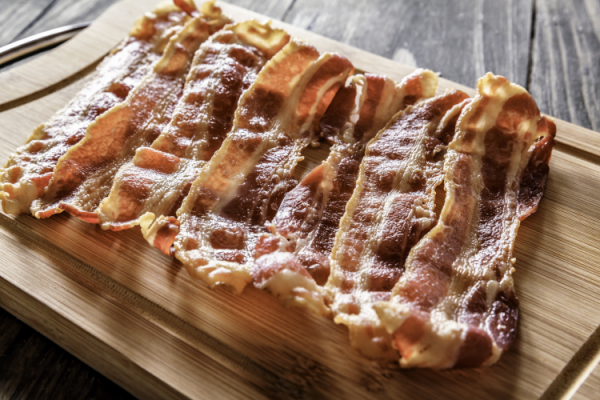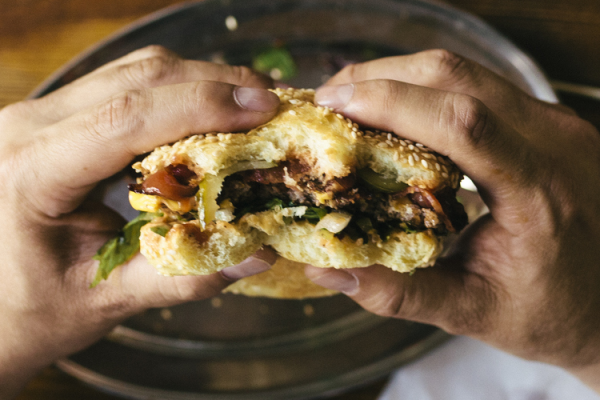Steakholder Foods, the cultured meat company formerly known as MeaTech, was the first – and is still the only – cultivated meat innovator listed on the Nasdaq stock exchange. Beginning in 2019, Steakholder set out to produce whole cuts of meat using cellular agriculture and 3D bioprinting. The Israel-based food tech company takes stem cells from animals and – using a growth media and clean energy – grows muscle and fat cells in bioreactors.
It then differentiates the cells and the company’s proprietary 3D bioprinting technology prints whole cuts of meat at an industrial scale to create ‘any ratio’ of muscle tissue and fat marbling, without damaging cell viability. It was recently granted its first patent (among numerous pending patents) for systems and methods that enhance muscle fibre formation to develop high-quality meat.
“For us, it’s always been [about] pushing our R&D to new levels,” chief executive Arik Kaufman reflected. “This moonshot mentality, as we like to call it, is what got this company and our R&D effort off the ground. It was our desire to tackle the most complex challenge in the field of cultured meat — 3D printing cultured steak that would be indistinguishable from a conventional whole cut of meat. This specific and ambitious initial goal is what enabled us to attract the best and brightest biologists and engineers in the field. And now that we have them, we are able to constantly push our R&D to the next level.”
Having started its innovation journey in beef, Steakholder is growing its capabilities in poultry, seafood and pork through internal R&D alongside a series of strategic acquisitions and tie-ups. In 2021, the company acquired Belgian avian developer Peace of Meat; last month, it announced a collaboration with cultured seafood company Umami Meats; and earlier this week, Steakholder revealed it has started developing cultured pork products from a new line of iPS porcine cells. This new stem cell line was derived from cells reprogrammed back into an embryonic-like pluripotent state, enabling one cell bank to become an ‘unlimited and highly scalable’ source for developing ‘any type of muscle or fat cells for cultured meat production’, the company explained.

An evolving commercial model
Alongside its deep-tech R&D efforts, Steakholder Foods has also been evolving its commercial model. This journey has seen the company move from ‘strictly’ being a developer and B2B provider of 3D printing technology for cultured meat production to food manufacturers and retailers to ‘also being a producer of culture meat products in consumer-oriented markets’, the chief executive told FoodNavigator.
This shift has necessitated a re-brand that will communicate the new proposition. “As our commercialisation strategy has evolved from B2B to B2B2C, the logical next step was to rebrand ourselves as primarily a food company. We wanted a name that would reflect the fact that ultimately, our aim is to produce delicious, nutritious food. We also wanted a name that would communicate our desire to build an open community of meat lovers who care about the environmental and social issues surrounding the conventional meat industry and wish to participate in our mission to make real meat sustainable,” Kaufman explained.
“The ‘how’ part is obviously still very important. Our technological capabilities are one of the main things that makes us unique in this industry. And being a B2B provider of 3D-bioprinting technology is still very much an aspect of our business model.”
As its first step towards commercialisation, Steakholder now is focused on developing hybrid products through its Belgian subsidiary Peace of Meat in collaboration with B2B mycoprotein supplier ENOUGH. “Peace of Meat’s cultured avian biomass will add the signature flavours, aromas and textures of conventional meat to plant-based products, such as chicken nuggets, patties and meatballs,” Kaufman predicted.
“With its new game-changing hybrid food products that will come closer to mimicking the taste and texture of conventional meat, Steakholder Foods intends to capitalise on the growth of the plant-based meat substitute market, a sector that shares our sustainability mission and concerns about the issues surrounding the conventional meat industry. We expect these new products will have strong appeal among flexitarians and others who still love meat but because of ethical, moral or environmental concerns, have decided to reduce their meat intake.”
Three ‘main hurdles’ remain
This resonance with a consumer already looking to make changes to their diet – often for sustainability or animal welfare reasons – is important because, Kaufman suggested, acceptance is one of the three ‘main hurdles’ facing the cultured meat industry, alongside cost and scalability.

While regulatory approval has to date only been granted in Singapore, Kaufman is confident other regulators will follow suit and suggested this is not the ‘biggest’ issue standing in the way of the emerging technology. “The completion of regulatory approvals will most likely help with public acceptance. But in this regard, it is primarily on the shoulders of industry players and advocates to properly educate the public on the virtues and benefits of cultured meat,” he elaborated.
Kaufman was also upbeat on the cost outlook, which he described as ‘decreasing all the time’. “Growth factors for use in cell media have been a big contributor to high cost. We are constantly working to reduce the cost of cell media. Scaling will also bring costs down. One major missing element for scalability has been technology infrastructure. And a big advantage Steakholder Foods has (and a reason why we are at the forefront of our sector) is that we are developing the technology infrastructure that will allow for effective scalability and manufacturing flexibility (based on market demands) the industry will require in the coming years.
“Our ongoing R&D and marketing efforts together are addressing all three of these issues – cost, scalability and public acceptance. And soon after we get the regulatory greenlight, the general public will be able to experience the high quality of our products from the standpoint of taste, texture, nutrition, and safety. Cost, scalability and quality will all effect public acceptance. Public acceptance will signal that we have successfully moved beyond all three hurdles. And as public acceptance grows, our scaling efforts will increase which will help to continue lowering costs.”

